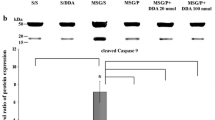Abstract
Glaucoma is a neurodegenerative disease in which increasing intraocular pressure leads to the progressive loss of retinal ganglion cells (RGCs) and blindness. Here, we report a neuroprotective effect of pituitary adenylate cyclase-activating polypeptide (PACAP) against RGC loss induced by high intraocular pressure in the rat. Vehicle or PACAP (1 fM to 1,000 pM) solution was injected into the vitreous body once after induction of a high intraocular pressure (110 mmHg). Seven days later, the number of viable RGCs was reduced to 45% of that in the intact control. However, PACAP treatment significantly reduced this RGC death in a bimodal manner, with peaks at 10 fM and 10–100 pM. The cAMP antagonist Rp-cAMP significantly blocked the neuroprotective effect of PACAP at both high and low doses, whereas the MAP kinase inhibitor PD-98059 only prevented the effect of the low dose of PACAP. These findings suggest that PACAP has bimodal effects in the neuroprotection of RGCs against ischemia and that these effects are mediated via different signaling pathways.



Similar content being viewed by others
References
Arimura A (1998) Perspectives on pituitary adenylate cyclase activating polypeptide (PACAP) in the neuroendocrine, endocrine, and nervous systems. Jpn J Physiol 48:301–331
Brenneman DE, Hauser JM, Spong C, Phillips TM (2002) Chemokine release is associated with the protective action of PACAP-38 against HIV envelope protein neurotoxicity. Neuropeptides 36:271–280
Drago F, Vallzeli S, Emmi I, Marino A, Scalia CC, Marino V (2001) Latanoprost exerts neuroprotective activity in vitro and vivo. Exp Eye Res 72:479–486
Kido N, Tanihara H, Honjo M et al (2000) Neuroprotective effects of brain-derived neurotrophic factor in eyes with NMDA-induced neuronal death. Brain Res 884:59–67
Kisiswa L, Dervan AG, Albon J, Morgan JE, Wride MA (2010) Retinal ganglion cell death postponed: giving apoptosis a break? Ophthalmic Res 43:61–78
Kong LY, Maderdrut JL, Jeohn GH, Hong JS (1999) Reduction of lipopolysaccharide-induced neurotoxicity in mixed cortical neuron/glia cultures by femtomolar concentrations of pituitary adenylate cyclase-activating polypeptide. Neuroscience 91:493–500
Li M, David C, Kikuta T, Somogyvari-Vigh A, Arimura A (2005) Signaling cascades involved in neuroprotection by subpicomolar pituitary adenylate cyclase-activating polypeptide 38. J Mol Neurosci 27:91–105
Miyata A, Arimura A, Dahl RR et al (1989) Isolation of a novel 38 residue-hypothalamic polypeptide which stimulates adenylate cyclase in pituitary cells. Biochem Biophys Res Commun 164:567–574
Nakatani M, Seki T, Shinohara Y et al (2006) Pituitary adenylate cyclase-activating peptide (PACAP) stimulates production of interleukin-6 in rat Muller cells. Peptides 27:1871–1876
Ohtaki H, Nakamachi T, Dohi K et al (2006) Pituitary adenylate cyclase-activating polypeptide (PACAP) decreases ischemic neuronal cell death in association with IL-6. Proc Natl Acad Sci U S A 103:7488–7493
Onoue S, Endo K, Ohshima K, Yajima T, Kashimoto K (2002) The neuropeptide PACAP attenuates b-amyloid (1–42)-induced toxicity in PC12 cells. Peptides 23:1471–1478
Quigley HA, Nickells RW, Kerrigan LA, Pease ME, Thibault DJ, Zack DJ (1995) Retinal ganglion cell death in experimental glaucoma and after axotomy occurs by apoptosis. Invest Ophthalmol Vis Sci 36:774–786
Rácz B, Tamás A, Kiss P et al (2006) Involvement of ERK and CREB signaling pathways in the protective effect of PACAP in monosodium glutamate-induced retinal lesion. Ann N Y Acad Sci 1070:507–511
Seki T, Nakatani M, Taki C et al (2006) Neuroprotective effect of PACAP against kainic acid-induced neurotoxicity in rat retina. Ann N Y Acad Sci 1070:531–534
Seki T, Itoh H, Nakamachi T, Shioda S (2008) Suppression of ganglion cell death by PACAP following optic nerve transection in the rat. J Mol Neurosci 36:57–60
Shioda S, Ozawa H, Dohi K et al (1998) PACAP protects hippocampal neurons against apoptosis: involvement of JNK/SAPK signaling pathway. Ann N Y Acad Sci 865:111–117
Shioda S, Ohtaki H, Nakamachi T et al (2006) Pleiotropic functions of PACAP in the CNS: neuroprotection and neurodevelopment. Ann N Y Acad Sci 1070:550–560
Shoge K, Mishima HK, Saitoh T et al (1999) Attenuation by PACAP of glutamate-induced neurotoxicity in cultured retinal neurons. Brain Res 839:66–73
Uchida D, Arimura A, Somogyvári-Vigh A, Shioda S, Banks WA (1996) Prevention of ischemia-induced death of hippocampal neurons by pituitary adenylate cyclase activating polypeptide. Brain Res 736:280–286
Vaudry D, Pamantung TF, Basille M et al (2002) PACAP protects cerebellar granule neurons against oxidative stress-induced apoptosis. Eur J Neurosci 15:1451–1460
Villalba M, Bockaert J, Journot L (1997) Pituitary adenylate cyclase-activating polypeptide (PACAP-38) protects cerebellar granule neurons from apoptosis by activating the mitogen-activated protein kinase (MAP kinase) pathway. J Neurosci 17:83–90
Acknowledgement
This study was supported by Ministry of Education, Science, Sports, and Culture of Japan and in part by a High-Technology Research Center Project from the Ministry of Education, Science, Sports, and Culture of Japan.
Author information
Authors and Affiliations
Corresponding author
Rights and permissions
About this article
Cite this article
Seki, T., Itoh, H., Nakamachi, T. et al. Suppression of Rat Retinal Ganglion Cell Death by PACAP Following Transient Ischemia Induced by High Intraocular Pressure. J Mol Neurosci 43, 30–34 (2011). https://doi.org/10.1007/s12031-010-9410-5
Received:
Accepted:
Published:
Issue Date:
DOI: https://doi.org/10.1007/s12031-010-9410-5




